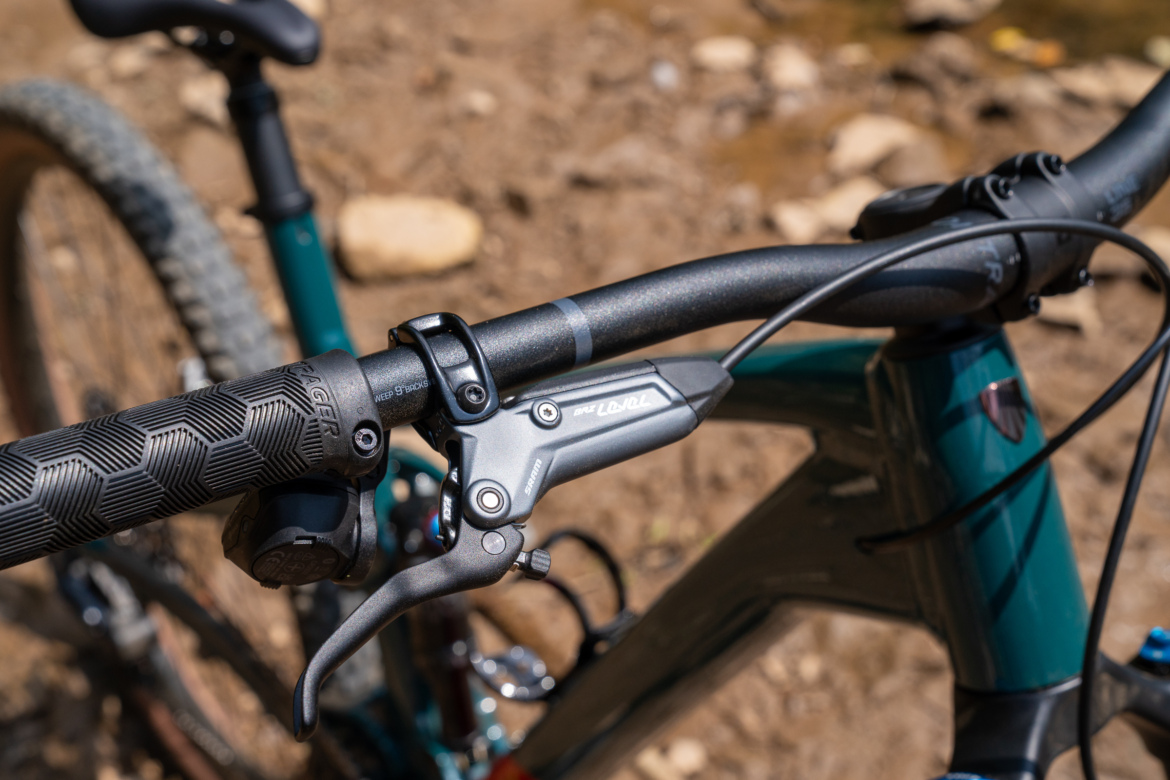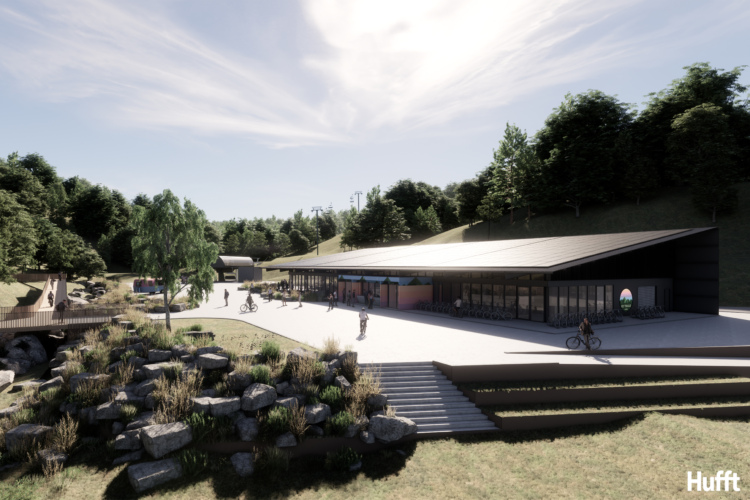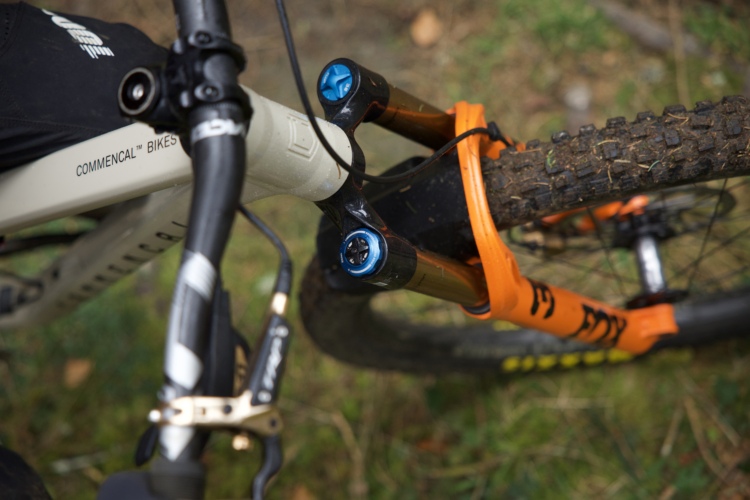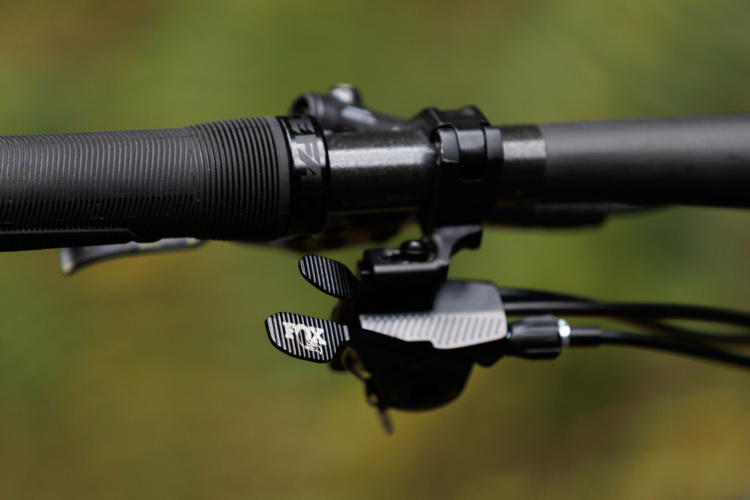
Mountain bikes are becoming much more customizable, and the Trek Top Fuel is no exception. With multiple travel, geometry, and progression adjustments available, the Top Fuel is capable of spanning from cross-country to trail bike and everything in between. I’ve ridden the fourth-generation Top Fuel hundreds of miles over the past nine weeks, and while I think the bike leans one direction more than the other, overall, it’s a very capable and versatile bike.
In this review


On the trail
Right out of the box, the Trek Top Fuel feels snappy, given its racy geometry and short travel. However, the aluminum alloy Top Fuel 9 Gen 4 build that I tested isn’t lightweight by any means, with my XL sample weighing almost 32lb on the dot without pedals.
Reviewer profile height: 190cm (6’3″) weight: 75kg (165lb) testing zone: Southeast, USA
Most of my test rides could be classified as cross-country slash trail rides, and the bike clearly excels at this type of riding. I found that it’s an efficient climber and a pretty capable descender, too.

Climbing and pedaling
As a short-travel trail bike, the Trek Top Fuel is naturally biased toward pedal efficiency. On most mountain bikes, I can get away with spending the majority of my time riding with the shock in the open damper position, but I quickly learned that the Top Fuel begs the shock to be in firm mode for pedaling and climbing. With the damper set to closed, the bike rockets up climbs and accelerates from a stop like a Tesla Model S Plaid. It’s unequivocally efficient and stable.

Mashing in open mode, however, the pedal bob is not just noticeable, it’s downright disheartening. Last year I tested the Canyon Lux Trail, and in a lot of ways the bikes feel very similar. In my review of that bike, I sorta dragged Canyon for including a shock remote on a downcountry bike, a feature that I usually associate with race bikes, not everyday short-travel trail bikes. Well, today I’m here to eat my words: this downcountry bike could truly benefit from a shock remote, especially when riding rolling trails with countless short climbs and descents. Or better yet, a Fox Live Valve or RockShox Flight Attendant shock.
The latest Santa Cruz bikes are seeing reduced anti-squat, and when considering how reliant the Top Fuel is on the shock’s climb switch, I think both brands are probably onto something. After all, if a lot of us are riding our trail bikes with the shock in “open” mode for most of our rides, that suggests to me that the suspension is leaving something on the table when it comes to the descents.
I tested a size XL Top Fuel, which Trek recommends for riders who are 6’2″ to 6’5″ tall. I’m about 6’3″, and with the Mino Link flip chip in low geometry mode, the bike puts me in a very racy, XC position. It feels fast on short, high-power rides, but on longer days, I’m stretched and hunched over more than I would like.

At the start of one of my first test rides aboard the Top Fuel, a friend — who I’ve been riding with regularly for years — remarked that the bike looked like it was a size too small for me. I’m not sure that’s the case — the 507mm reach is at the higher end of my comfort zone already — plus there isn’t a larger size available anyway. The relatively low 630mm stack height likely plays a role, and while a low stack height is an advantage for racing where an aggressive, aerodynamic position pays off, it’s not my first choice for all-day climbing in search of fast descents.
Share your Trek Top Fuel review
ICYMI, Trek athlete Riley Amos, who won the overall 2024 U23 World Cup XCC and XCO titles, took 7th at the last race of the season aboard a Trek Top Fuel, and his was set up with a shorter, 120mm fork. Clearly, this is a capable race bike, and I would argue that even though the bike is highly adaptable (and my setup is far less race-oriented than his), it still leans more toward XC racing than a typical downcountry or short-travel trail bike.
With the shock in firm mode, I found the Top Fuel is plenty responsive to technical climbing over rocks and roots. The suspension feels poppy and makes sessioning particularly tricky climbs a fun exercise. On paper, the 75.2° effective seat tube angle isn’t all that steep, and yet the Top Fuel delivers a nice weight balance that keeps the front end from wandering and the rear wheel from slipping, even in steep and loose conditions.
Descending
When it comes to descending on the Trek Top Fuel, I honestly have zero complaints. The slack, 65.5° head tube angle really delivers, and the suspension, even in its stock, lower progression mode, soaks up the bumps and cushions hard landings. Here again, the bike has a tuned, racy feel rather than a plush, “out for a ride with the boys” feel, which is to be expected from a bike in this category.
I didn’t get a chance to try a longer fork and shock on the Top Fuel, though it’s an option. The bike can fit a longer-stroke shock for up to 130mm of rear travel, and Trek says a longer 140mm fork will fit too. This promises to change the character of the Top Fuel and make it an even more capable descender, though I don’t feel like the bike needs more than the stock 130/120mm of front and rear travel, at least for most of my rides.
The Trek Top Fuel features proportional chainstay lengths across the size range, and on my XL test bike the stays are 445mm long. That’s a little longer than the average bike I’m used to riding, and makes for a slightly less playful — and again, more efficient and racy — ride feel.


As far as the build is concerned, the Fox Rhythm 34 fork and Performance Float DPS shock performed great on the descents. The SRAM Level Bronze brakes, despite boasting a four-piston design, felt a little underpowered. I suppose this is fitting for a race bike where the mantra “all gas, no brakes” usually pays off.
I was pleasantly surprised at how well the fast-rolling 29×2.4″ Bontrager Gunnison Pro XR tires handled in a variety of conditions. I tested a wider, 2.6″ set of Gunnison tires on a Trek Marlin+ earlier this year, and they were just… OK. The 2.4″ version proved to be much more capable, delivering excellent cornering traction and climbing grip with average braking traction.

Geometry and bike fit adjustments
For most of my test rides, I kept the Mino Link in the standard “low” geometry position, but I also tried it in “high” to see if I could get a more comfortable fit. Overall, I think I prefer high, with the slightly steeper seat and head tube angles. However, the trade-off is an even longer 512mm reach and lower stack height.
In terms of handling, the “high” position shifts the performance balance from descending to climbing. With essentially no complaints about the Top Fuel’s descending capabilities, I personally found this to be a net improvement in both character and efficiency.

Frame features
The four-position Mino Link not only adjusts the bike’s geometry and suspension curve, it also allows buyers to run mixed wheels for sizes medium and larger. (The size small bikes ship with matched 27.5″ wheels and are not designed to run a 29er wheel in front.)
Trek Top Fuel key specs
- 130/120mm suspension travel front/rear, can also run 120/120mm or 140/130mm
- Four-position geometry and progression flip chip
- In-frame storage
- Carbon and aluminum frame options
- Weight: 32lb as tested (size XL)
- Price: $3,999.99 to $10,499.99, $4,799 for Top Fuel 9 Gen 4 tested
- Buy from Trek
Overall, Trek says they managed to shave about 220g off the carbon and aluminum frames, with some of the lightest builds weighing as little as 28.33lbs. With the previous version of the Top Fuel, Trek gave their Knock Block steering limiter a wider sweep. Now, Knock Block is gone altogether, thanks to a modified down tube that clears the fork stanchions even at extreme steering angles.

Rounding out the frame updates, Trek has revamped their in-frame storage solution by improving the frame door and latch and updating the included BITS storage bags. I found the latch is much easier to use and attaches securely with very little effort. The storage space isn’t quite as large as on some other bikes I’ve tested; for example, I couldn’t fit a standard 29er tube inside.
I like the Juniper-color glossy paint job on this particular model. Depending on the light, it either looks green or blue, and the gold lettering is boss. It does seem like the paint chips rather easily though; one spot on the down tube got chipped before I even rode the bike (perhaps in transit, or when I was setting it up), and there are white spots around the rear, brake-side dropout, likely from kicked-up rocks.

Geometry
Overall, I would characterize the Trek Top Fuel geometry as race-oriented. Sure, it’s not full-on race geo like a Supercaliber, but it does lean more XC for the most part. Drilling down, however, the geometry is mixed. A 65.5° head tube angle is pretty dang slack for an XC/downcountry bike. (It’s a full two degrees slacker than the Canyon Lux I tested last year.) The reaches are long, with the XL stretching up to 512mm in high mode, and combined with the low stack height, the frame puts riders in an aggressive pedaling position.
| S | M | ML | L | XL | |
|---|---|---|---|---|---|
| ST Length (mm) | 360 | 410 | 420 | 435 | 470 |
| Reach (mm) | 417 | 447 | 462 | 477 | 507 |
| Stack (mm) | 570 | 603 | 607 | 612 | 630 |
| BB Height (mm) | 342 | 345 | 345 | 345 | 345 |
| CS Length (mm) | 435 | 435 | 440 | 440 | 445 |
| Eff ST Angle (deg) | 76.0 | 76.9 | 76.2 | 75.9 | 75.2 |
| HT Angle (deg) | 65.5 | 65.5 | 65.5 | 65.5 | 65.5 |
| Wheelbase (mm) | 1151 | 1188 | 1210 | 1227 | 1271 |
| Front Center (mm) | 717 | 755 | 772 | 789 | 827 |
| Trail (mm) | 115 | 125 | 125 | 125 | 125 |
| Fork Offset (mm) | 43 | 43 | 43 | 43 | 43 |
| Standover Carbon (mm) | 700 | 750 | 752 | 753 | 758 |
Personally, I’d like to see the XL with a slightly steeper effective seat tube angle than 75.2°. This would make it an even more comfortable (and likely capable) climber, plus it would also serve to dial the reach back a little. Flipping the Mino Link to high does steepen the seat angle, but it moves reach in the opposite direction.




Build specs
The Trek Top Fuel 9 is the highest build level based around an aluminum alloy frame, and features a SRAM GX Eagle Transmission wireless electronic drivetrain. This is the fourth bike I’ve tested with GX Eagle Transmission, and it’s proven to be nearly flawless.
Aside from the SRAM brakes and drivetrain, and Fox suspension, pretty much everything else on the Top Fuel 9 is Bontrager badged (even the tire sealant and cable housing!). The Bontrager Line Comp 30 wheels, with alloy rims, proved durable and deliver a nice ride feel. The Bontrager cockpit is solid enough, though given my fit challenges with the frame geometry, I’d swap the stock 27.5mm rise bars for a set of bars with even more lift.
Trek specs a 170mm travel Bontrager Line dropper post for sizes medium and larger, which is a boon for riders at the start of the range but a letdown for those at the opposite end of the spectrum. I will say that the dropper post works really well—it’s responsive and pretty snappy—but it’s too short for me, and clearly, there’s room for a longer post on the XL frames.
Pros and cons of Trek Top Fuel Gen 4
Pros
- Efficient pedaling, as long as the climbing is shock set to firm
- A joy on descents
- Bontrager components are surprisingly solid
Cons
- Not as comfortable or playful as other downcountry bikes
- Fit might be tricky for some riders
- Can’t get away with leaving the shock open for the whole ride
Bottom line
In its stock configuration, the Trek Top Fuel is more long-travel XC than downcountry bike. However, for those who lean more toward one side of the divide than the other, the Top Fuel is highly customizable and promises to adapt to a decent range of riding styles.





















4 Comments
Oct 15, 2024
Oct 15, 2024
Oct 15, 2024
Oct 16, 2024